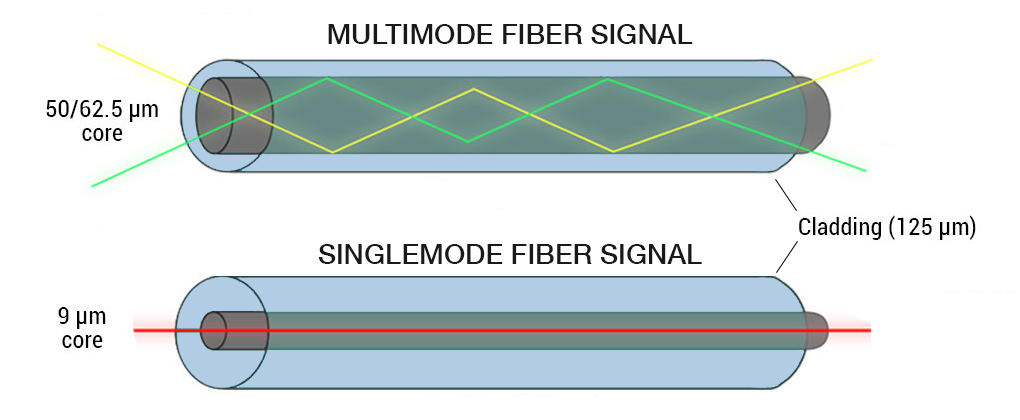Multimode vs Singlemode Fiber
The glass fiber used in fiber optic transmission consists of a central core upon which the signal is carried and a surrounding cladding which has a lower refractive index to contain the signal within the core. The cladding in most fiber today has an outside diameter of 125 microns. In comparison, the diameter of an average human hair is 85 microns. There are three popular sizes currently for the core diameter, 50 micron, 62.5 micron and 8 micron. Both 50 and 62.5 micron fiber are called multimode fiber. The 8 micron fiber is called singlemode fiber.
Based on the names given these fibers, first impressions would be that multimode fiber would be more efficient than singlemode fiber. However, the reverse is generally true.
The term multimode comes from the fact that light can travel in more than one path through the core of this fiber. The relatively large core allows light to travel both straight down the center or to bounce from side to side in a zigzag pattern. Light traveling from side to side takes longer going down the fiber than light traveling straight so the signal at the end of the fiber is dispersed. This dispersion effect does not become significant until the signal has traveled long distances such as a mile or more, or when data bits are packed close to each other.
The relatively small core found in singlemode fiber only allows one path of light directly down the center of the core. This keeps the signal intact for distances in excess of tens of miles.
Since singlemode fiber is half the cost of multimode fiber and it has more efficient signal transmission, the obvious question is: Why use multimode fiber? The answer is that the overall cost of an application is generally less expensive when done in multimode. This is because the transmitters and receivers required to convert electronic signals to fiber optic signals are three times more expensive in singlemode than in multimode.
Camera and control systems used in most security and surveillance designs typically use multimode fiber. The low speed data used in these systems allows for distances to three miles with the lower cost optics. Intercom and contact closure used for gates and alarms can also be transmitted up to three miles on multimode fiber. For long distance projects such as traffic management and distance learning, the extended range of singlemode optics is the transmission of choice.
Therefore, when designing a high data throughput or long distance application, a singlemode system is preferred. When designing an application which has a distance less than two miles with moderate data throughput, multimode is more economical.



